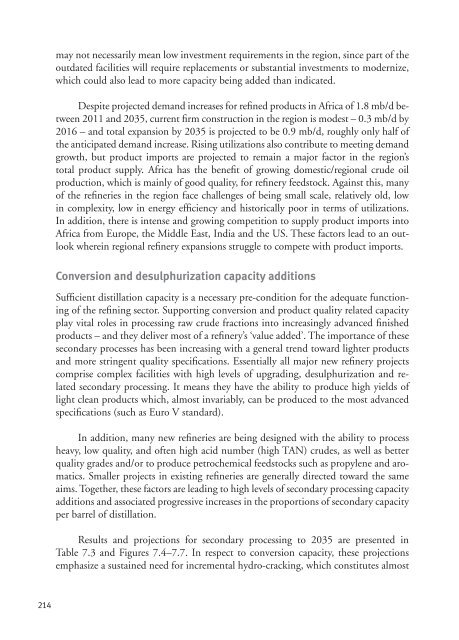World Oil Outlook - Opec
World Oil Outlook - Opec
World Oil Outlook - Opec
- TAGS
- world
- outlook
- opec
- www.opec.org
You also want an ePaper? Increase the reach of your titles
YUMPU automatically turns print PDFs into web optimized ePapers that Google loves.
214<br />
may not necessarily mean low investment requirements in the region, since part of the<br />
outdated facilities will require replacements or substantial investments to modernize,<br />
which could also lead to more capacity being added than indicated.<br />
Despite projected demand increases for refined products in Africa of 1.8 mb/d between<br />
2011 and 2035, current firm construction in the region is modest – 0.3 mb/d by<br />
2016 – and total expansion by 2035 is projected to be 0.9 mb/d, roughly only half of<br />
the anticipated demand increase. Rising utilizations also contribute to meeting demand<br />
growth, but product imports are projected to remain a major factor in the region’s<br />
total product supply. Africa has the benefit of growing domestic/regional crude oil<br />
production, which is mainly of good quality, for refinery feedstock. Against this, many<br />
of the refineries in the region face challenges of being small scale, relatively old, low<br />
in complexity, low in energy efficiency and historically poor in terms of utilizations.<br />
In addition, there is intense and growing competition to supply product imports into<br />
Africa from Europe, the Middle East, India and the US. These factors lead to an outlook<br />
wherein regional refinery expansions struggle to compete with product imports.<br />
Conversion and desulphurization capacity additions<br />
Sufficient distillation capacity is a necessary pre-condition for the adequate functioning<br />
of the refining sector. Supporting conversion and product quality related capacity<br />
play vital roles in processing raw crude fractions into increasingly advanced finished<br />
products – and they deliver most of a refinery’s ‘value added’. The importance of these<br />
secondary processes has been increasing with a general trend toward lighter products<br />
and more stringent quality specifications. Essentially all major new refinery projects<br />
comprise complex facilities with high levels of upgrading, desulphurization and related<br />
secondary processing. It means they have the ability to produce high yields of<br />
light clean products which, almost invariably, can be produced to the most advanced<br />
specifications (such as Euro V standard).<br />
In addition, many new refineries are being designed with the ability to process<br />
heavy, low quality, and often high acid number (high TAN) crudes, as well as better<br />
quality grades and/or to produce petrochemical feedstocks such as propylene and aromatics.<br />
Smaller projects in existing refineries are generally directed toward the same<br />
aims. Together, these factors are leading to high levels of secondary processing capacity<br />
additions and associated progressive increases in the proportions of secondary capacity<br />
per barrel of distillation.<br />
Results and projections for secondary processing to 2035 are presented in<br />
Table 7.3 and Figures 7.4–7.7. In respect to conversion capacity, these projections<br />
emphasize a sustained need for incremental hydro-cracking, which constitutes almost
















